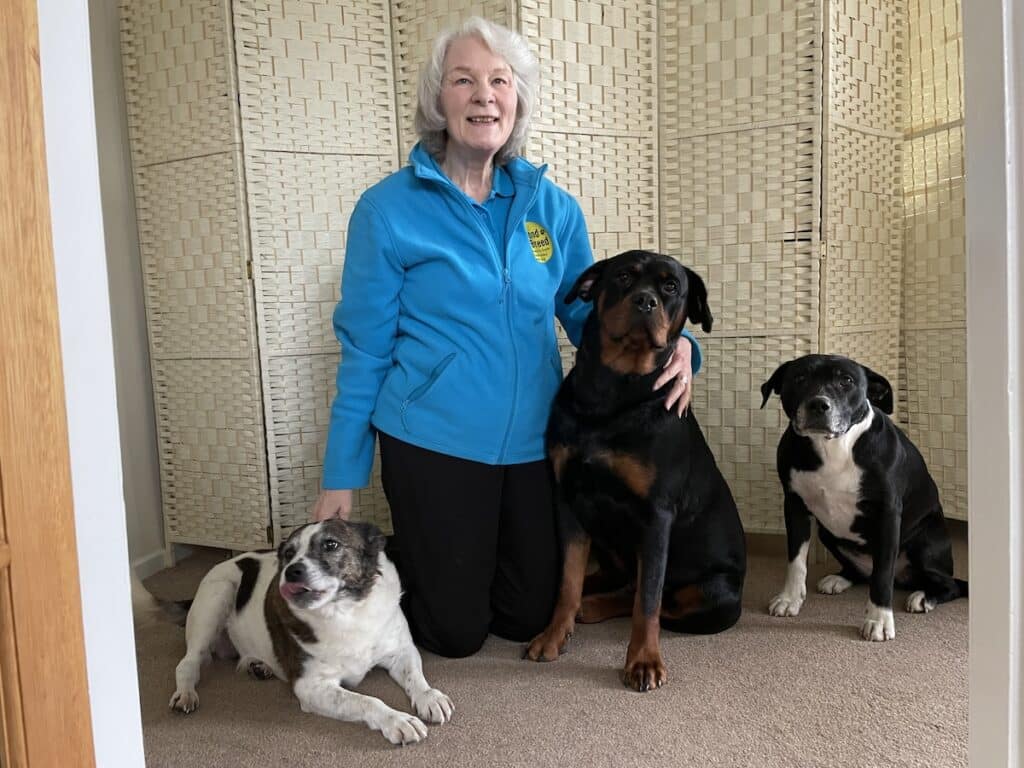Having a dog that barks a lot can be challenging and very stressful for owners.
Whenever I see someone with a reactive dog my heart goes out to them.
Many are rescue dogs and you have to admire the owner for taking on a dog many would walk past,
I truly believe they deserve kindness and compassion.
Often you’ll see people glare and huff at a barking dog, leaving the owner feeling embarrassed and distressed.
It must be a lonely place for them but they stick with it out of love for their animal.
Dog trainer Claire Lawrence has written a book, You’d Be Barking Mad Not To, tackling this taboo topic which is part of her Three Steps to Silence series out this week.
She specialises in dealing with barking dogs, and shares her advice for owners both as a pet professional and someone who has been there herself.

How did you come to niche down to working with barking dogs?
Although I’ve worked and lived with barking dogs for a long time, it’s a taboo topic.
A lot of barking dogs happen through mistakes made from people in thinking it will go away or they’ll grow out of it.
From puppies to rescue dogs, many people either give up or learn to adapt to and live with the barking and I having experienced it myself I wanted to help.
There’s a belief that only behaviourists and higher qualified people should work with these dogs.
Despite not having a string of qualifications, I decided to go down that road because I’m incredibly passionate about helping chaotic dogs back into calm.
And it was also because I have a lot of useful, proven to work and effective training methods to help people with barking dogs.
I won’t take on cases that are too much.
But there are things every single barking dog owner can be doing to prevent the barking from getting worse and often fix the problem all together.
From your experience what are the main reasons dogs bark?
It’s normally attention seeking, frustration and fear. There are many more forms of barking, but I’ve just focused on those three.
You can watch Claire share how her dog Titon inspired her to work with barking dogs and answer questions from owners in the video below
Can you tell me about the three different types of barks?
Attention Seeking
This pretty much what it says. They have learned they get attention from using that bark so they direct it to whatever they want the attention from.
Another dog, a person, a treat dispenser, a hosepipe spraying water. For most people, they think that ignoring this type of bark will fix the problem.
But it won’t. If the dog has learned the barking works, they will continue to try harder with the barking until you break.
Normally that involves just looking at or speaking to the dog in whatever tone is enough to reward that behaviour.
Frustration
Human and canine behaviour collides often and this is about a lack of access to the thing the dog wants.
I tend to see this more in dogs that have been allowed to play freely with other dogs.
The thing here is that not every dog wants to be met, which I’ll come onto shortly and really not every dog should be greeted.
Dogs can’t differentiate between what they can and can’t do, who they can and can’t meet so levels of frustration rise.
The human gets stressed because the dog is pulling, lunging, biting or barking on the lead and then the dog gets taken over to what they want.
The dog has learned these behaviours works for them.
Fear
Inadvertently, people misinterpret this bark so much and I die a little inside when people refer to it as being aggressive or just over excited.
The problem with fear barking is the dog doesn’t look scared. People think a scared dog cowers, backs away and specifically looks worried.
How can a dog baring teeth, spitting saliva and rearing up on their hind legs possibly be scared?
I know this because I made the very same misjudgment with my own dog, Titon.
I was telling him off for being ‘aggressive’ he was screaming out for that thing to get away from him. Titon was barking for dogs to go away.
Not every dog has good experiences, and once these experiences hurt or worry the dog, it isn’t long before they learn to use this barking to say, ’Back off or I will protect myself’

How does this affect their mental and emotional wellbeing?
Some barks out there that are 110% normal and a clear expression of communication levels in the dog.
The barking I am referring to is the chaotic and out of control type and mentally and emotionally this puts huge strain on the dog.
In terms of fear barking, day after day, dogs are being put into a situation where they feel they have to bark.
Imagine that scenario your mind is telling you to fight in order to stay alive.
If you’ve ever suffered from stress and constant fear, you’ll know the impact that has on your emotional and physical wellbeing. This is why I wanted to help barking dogs.
There must be a huge amount of frustration with owners and their pets because – sadly – we can’t talk to them and find out what is wrong can we?
Owners that misinterpret what the dog is really saying a bit like Chinese whispers. The original message is lost and the dog is in a state of high emotion.
Things get worse as the dog continues to try and communicate what’s upsetting them and the human tries to get them to stop.
That’s usually them telling them off, and often anger rises and they physically punish them by correcting with a lead yank or by hitting them.
But there is good news. You CAN communicate with your dog, and do so in a language they will fully understand.
Ok, so what’s the best way to communicate with barking dogs?
Dogs know we aren’t dogs. But what they do know and understand is how we move.
Have you ever blinked at your dog and they reciprocate the behaviour? This is actually a form of communication. It’s a calming signal that dogs use to diffuse a situation.
Another is yawning. I will randomly yawn in the presence of a new dog it’s because I want to let them know they don’t have anything to worry about.
I will not interact or bother them IF they don’t feel secure enough in my presence.
Usually, if I ignore the dog they’re sitting by my side and working for me within a matter of minutes.
The key is silence. You don’t need to talk to your dog.
I talk a lot in my training videos and classes but I’m not talking to the dog. In fact the less I can say the better when I’m training.
I’ve even done a live video with masking tape over my mouth!

You must meet owners in desperate situations who come to you because they want to keep their dog, how do they usually feel?
People are at the end of their tether. They’ve tried everything and got nowhere. The worst part about it is these people genuinely love their dog.
Having a barking dog is stressful and we’re only human, it’s natural that we feel angry and embarrassed towards our barking dog.
The most logical thing people think they have to do is to correct the barking to make it stop as quick as possible, sometimes by lashing out verbally or physically.
But this only ever makes things worse.
When I work with people in complete despair, I first work with them to rebuild their confidence and trust and show them how to enjoy time together again.
Because at the heart of everything else, it’s those things that have been lost. Confidence and Trust.
If we focus more on the emotion being presented from the dog, then our own emotions change really quickly.
When we learn it’s fear that we are dealing with, rather than aggression, we want to comfort and reassure them.
If we can learn to change how we respond, the results are truly magical.
What are you tips for coping?
Remember you are only human and you’re trying to do your best for your dog.
Be kind to yourself and be mindful we all have good and bad days.
1. Go out in a positive mindset. Your dog will pick up on your emotions.
2. Be prepared with toys, treats, contact training to dip into when you need it. It doesn’t matter what reward you use, just distract your dog from barking.
3. Avoid busy places or if the barking is in the house take your dog into another room or out in the garden when the postman arrives.
4. Support your dog often but please be careful touching your dog if they are barking. There are rules and safety precautions with this.
5. Seek professional and medical advice. This is key in the starting stages with your barking dog. You can’t fix a barking dog if they are using the barking through pain.
Ask your vet for a blood test and X ray to make sure there are no underlying health issues.
You can find lots of training videos, podcasts, blogs and other learning material from Claire on her website www.highpeakdogservices.co.uk
If you need help with your barking dog you can buy her new book, Three Steps to Silence here on Amazon or visit her Three Steps to Silence site here www.3sts.co.uk/
If you found this post helpful you might like to read Expert advice on coping with an anxious dog with Helen Motteram or Mindful living and our dogs with Caroline Wilkinson.





